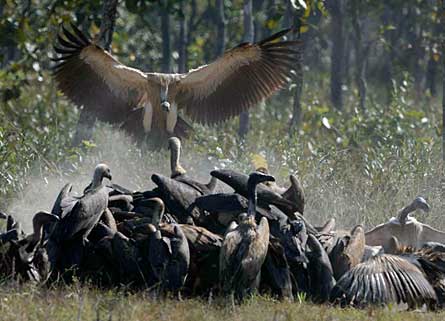Vultures get their day
As carrion feeders, vultures are essentially garbage collectors of the avian world. Usually big, ungainly and found frequenting stinky environs, these birds are anything but charismatic. They won’t win beauty contests either. But they perform an important role in natural ecosystems. And many have been disappearing across the globe at disturbingly rapid rates. That’s why the wildlife-conservation community has decided to honor these animals with International Vulture Awareness Day – which just happens to be today.
Currently, the Switzerland-based International Union for the Conservation of Nature lists 23 species of vultures as in trouble. The Egyptian, Indian, white-rumped, red-headed and slender-billed vultures – along with the California condor, a New World vulture – are all “endangered” with extinction. IUCN finds another five species are vulnerable to or near-threatened with extinction.
In many instances, human activities have indirectly imperiled the birds. For instance, California condors have died from lead poisoning after eating the remains of animals that had been felled by hunters using lead shot. Some populations of vultures in India, Nepal and Pakistan plummeted to five percent of their former abundance during the 1990s after feasting on the carcasses of cattle that had been treated with an anti-inflammatory drug, diclofenac.
According to Vulture Rescue, a collaboration of conservation organizations and individuals, “population modeling has shown that less than 1 percent of carcasses need to contain a lethal quantity of diclofenac for this drug to be the main, or only, cause of the decline in vulture numbers.”
This drug’s use on dogs has further aggravated the problem, as vultures will feed on canine carcasses as well. Indeed, that’s spurred Chris Bowden, vulture-program manager for the Royal Society for the Protection of Birds, to observe that “When describing the habitat of vultures, it is important to remember that a safe food source is an essential component. It may not be a conventional image of a conservation initiative to go out and lobby local vets and farmers to take care not to use a certain veterinary drug, but this is actually what the vultures most need us all to do.”
Another suspected link between vultures and dogs: rabies.
With the virtual extirpation of India’s vultures, owing to the diclofenac debacle and loss of vulture nesting habitat, lots of animal carcasses are now available to feed a burgeoning population of rats and other opportunistic feeders, such as feral dogs. Rhishja Larson wrote about the Indian situation in a July 24 EcoWorldly piece, noting that “India now has the highest rate of human rabies in the world, partly due to the increase in feral dogs. In fact, the rabies problem is so widespread that India has launched a plan to sterilize over 8 million dogs over the next ten years.”
Nor should people expect that dogs and other scavengers will clean up carcasses efficiently. Most pick at dead animals, eating the parts they like and leaving the rest. By contrast, vultures are masters of the pick-the-bone-clean diners. A flock can descend on an animal, even a cow, and a couple hours later depart from this impromptu “restaurant” leaving no flesh behind. Which would you rather have sitting around the neighborhood: A pile of bones or maggot-infested, slowly decomposing animal remains? Uh, that would seem a no-brainer.
So let’s give these funky looking birds the respect they deserve.







